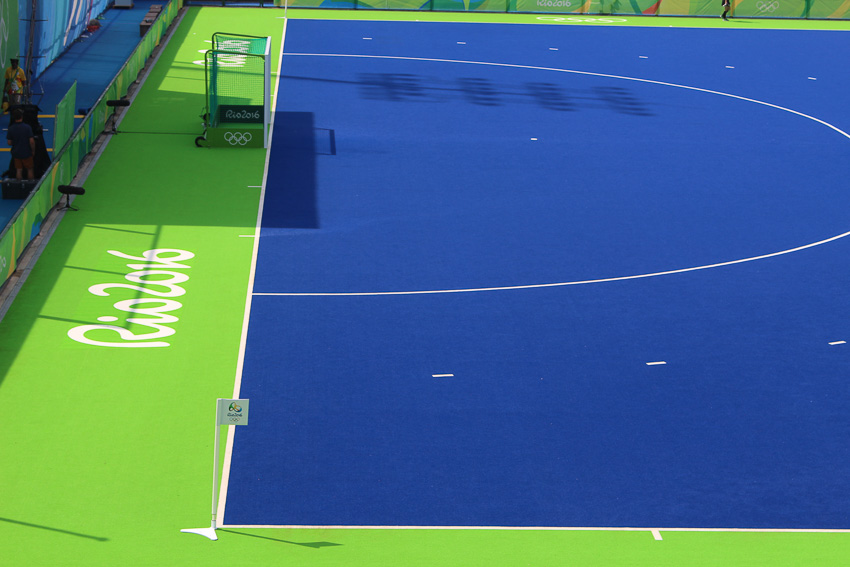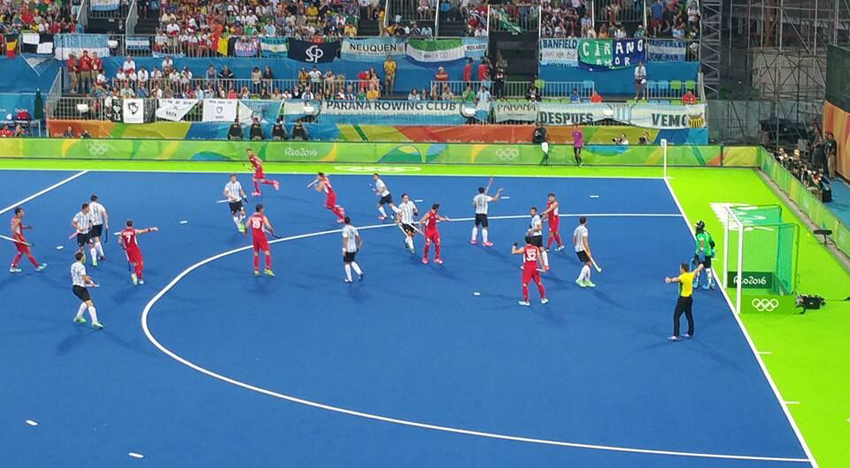
Rio de Janeiro now has one of the most impressive hockey facilities in the world, with a double pitch at the Deodoro Stadium and two more high performing turfs at the neighboring Federal University of Rio. Built by the leading pitch manufacturers in the world, such an abundance of top quality pitches should be the catalyst for a host of hockey activities; a growth in participation and the opportunity to host international competitions.
But, with the memory of the Olympic Games receding into the distance, there is a distinct lack of activity around getting the pitch up and running. Bruno Patricio is general manager of the Confederação Brasileira de Hóquei and he explains that “we are not using the pitch yet, the Ministry of Sport and the military are still dealing with some issues.
“But,” he says enthusiastically, “We expect to be using it by the end of the year. We hope Deodoro Stadium will be our High Performance Training Centre, which will be used to develop the best Brazilian players and where the national teams and U-21 teams will train to compete in international tournaments. The Deodoro Stadium will also be used as the main stadium to host both national competitions and international events.”
Certainly the pitches themselves look stunning, and most players and coaches agreed that they were fantastic to play on.
There can certainly be no doubting the quality of the pitches. When it comes to Olympic performances, there have been few more consistent performers than Dow Chemicals, one of the companies behind the hockey pitches at both London 2012 and the Deodoro Stadium in Rio 2016.
The relationship between Dow and the Olympic movement is more all-encompassing than purely pitch provision. In 2010 Dow signed a 10-year deal with the International Olympic Committee and became the Official Chemistry Company of the Olympic Games. The sponsorship extends to 2020, and, as part of the agreement, Dow’s aims are to use "its chemistry, technology, and science" to help make the Olympic Games "more sustainable, higher performing, and safer" for participants.
The pitch at Rio 2016 was the product of a partnership between Polytan STI, a manufacturer and supplier of outdoor and indoor sports surfaces and Dow – a partnership that has seen multiple pitches being supplied across the globe.
But it is the pitch at Deodoro that has been at the heart of the action in the past months and it was certainly an eye-catching sports stadium. Earlier in the year, test events had included an unveiling of an important component of Rio 2016’s “Look of the Games” visual identity: the colors of the field-of-play. This was a much-anticipated feature since the success of London 2012’s Riverbank Arena and its iconic blue and pink pitch. For Rio, the Rio 2016 Organizing Committee and the International Hockey Federation (FIH) opted for a blue pitch with green sidelines – a color pattern that matched Rio 2016’s visual identity and reflected the vivid spirit of the first-ever Brazilian Olympic Games.
The playing performance and quality of the pitch were a primary concern when developing the hockey turf system for Rio 2016. The tufted samples were inspected by the Rio 2016’s Venues Management and Look of the Games teams, as well as the FIH and the Olympic Broadcast Service (OBS), to ensure the selected colors met the specific requirements for players, officials, spectators and broadcasters alike.
This latter point was an important one as Nathan Wiker, global marketing director for Dow Packaging and Specialty Plastics explains: “Hockey is a fast game. The colors of the pitch allowed the spectators in the stadium and on television to follow the action more clearly because of the deeper contrast between the ball and the pitch.”
The two key factors for the Rio Olympics organizers were the quality of the pitch for the players and the look of the pitch for the millions of television and online spectators around the world. Behind these two headline qualities are other, equally important, factors.
David Lopez is technical sales and development engineer for Dow and he says: “one of the biggest drivers for any artificial hockey turf today – not just in Rio – is water management. We have to produce a turf that is as efficient in its water usage as possible. We are working on artificial turfs all over the world and water management is desperately important in many of these areas.”
“It is also important that we provide solutions that are durable,” Lopez adds. “We are always looking to develop yarn and backing that has a long lifetime – our aim is to modify the depreciation of the turf.” That is good news for Rio 2016, reportedly the organizing committee was hugely over budget, so any hint of longevity in an expensive facility is to be welcomed.
The build for the pitches and warm-up area at Deodoro, as well as two additional pitches at the Federal University of Rio, was a huge project. And, according to feedback from the players and coaches, a successful one. All the pitches benefit from a playing surface that consists of specific high-performing materials formulated together in multiple layers. The surface system is designed to deliver enhanced durability for increased pitch life, and a consistent field-of-play throughout a busy competition schedule – a good sign for hosting some of the events that Patricio hopes to see happening at Deodoro sometime soon.
While not much is happening at Deodoro right now, at the Federal University, hockey has become a hot topic. It is a subject in its own right within the physical education course and the university pitches are in constant use by the students. For the future, Patricio says the pitches will also host national and state championships at U18 and U15 level and hockey clinics, holiday camps and coaching courses will all take place at the facility. In addition, the local clubs from Rio de Janeiro are already using the CT of Federal University facility to train for the national and state championships.
Is there an appetite for hockey in Brazil, a country that has for so long been all about soccer? Patricio certainly believes so. He says Brazil men’s participation in the Olympics has provided a catalyst for hockey growth. “The impact of the Olympic Games on hockey in Brazil was extremely positive. Due to the participation of Brazil and the fact that all hockey matches were streamed on television, hockey had an important visibility in the whole country and, since the end of the Olympic Games, we have been contacted by several institutions outside Rio de Janeiro asking the Brazilian Federation to start hockey in their locations.”
It is a point that Brazil’s, Stephane Vehrle-Smith agrees with: “Despite the heavy losses we suffered, the reaction in Brazil has been great. People ranging across all ages have picked up a stick and are giving hockey a go. Many Brazilians who tuned in or watched live during the Olympics found the sport very exciting and lots of kids were inspired by it. This is a brilliant thing to see and I hope the sport continues to grow within the country and South America.”
For Patricio, what is needed for development to happen is a consistent, joined up approach. “To achieve real development, we believe that hockey needs to be practiced by children, adolescents and adults from all social classes. This is the reason why we are bringing hockey to public and private schools, universities, and clubs. We expect to expand significantly the number of players, coaches and supporters in Brazil in the next years, and the Olympic legacy will be primordial to achieve this goal.”
For onlookers who are concerned that state of the art facilities might descend into expensive white elephants, signs of hockey activity at the Deodoro are eagerly anticipated.

